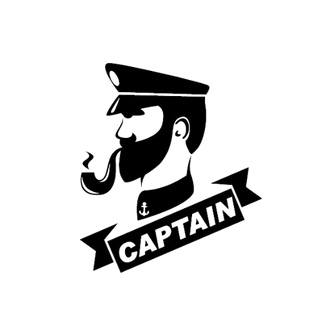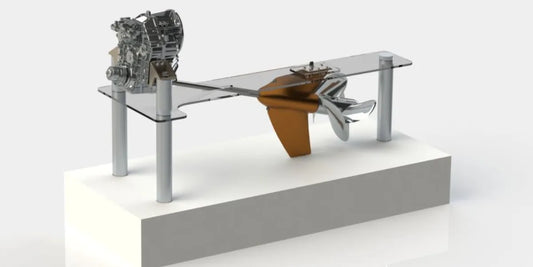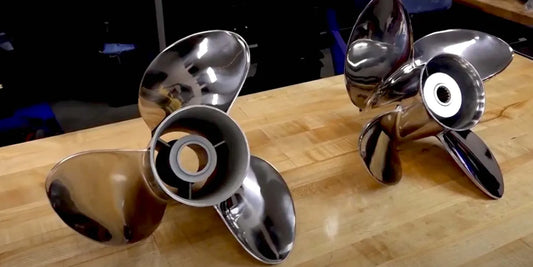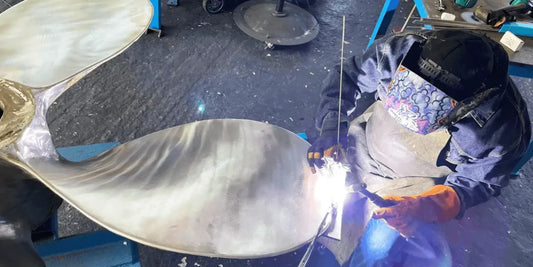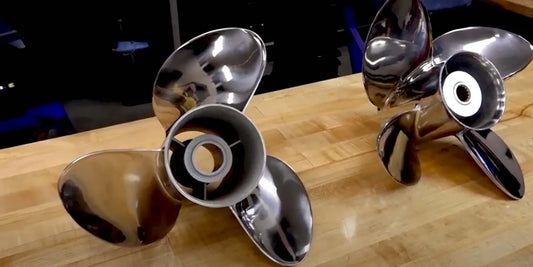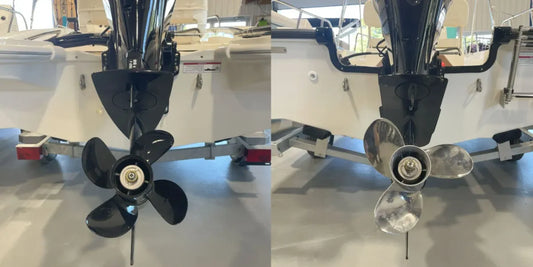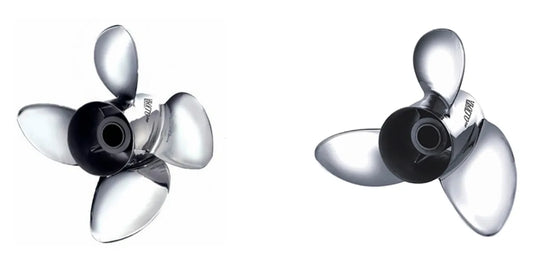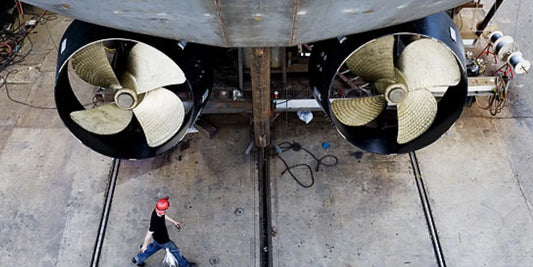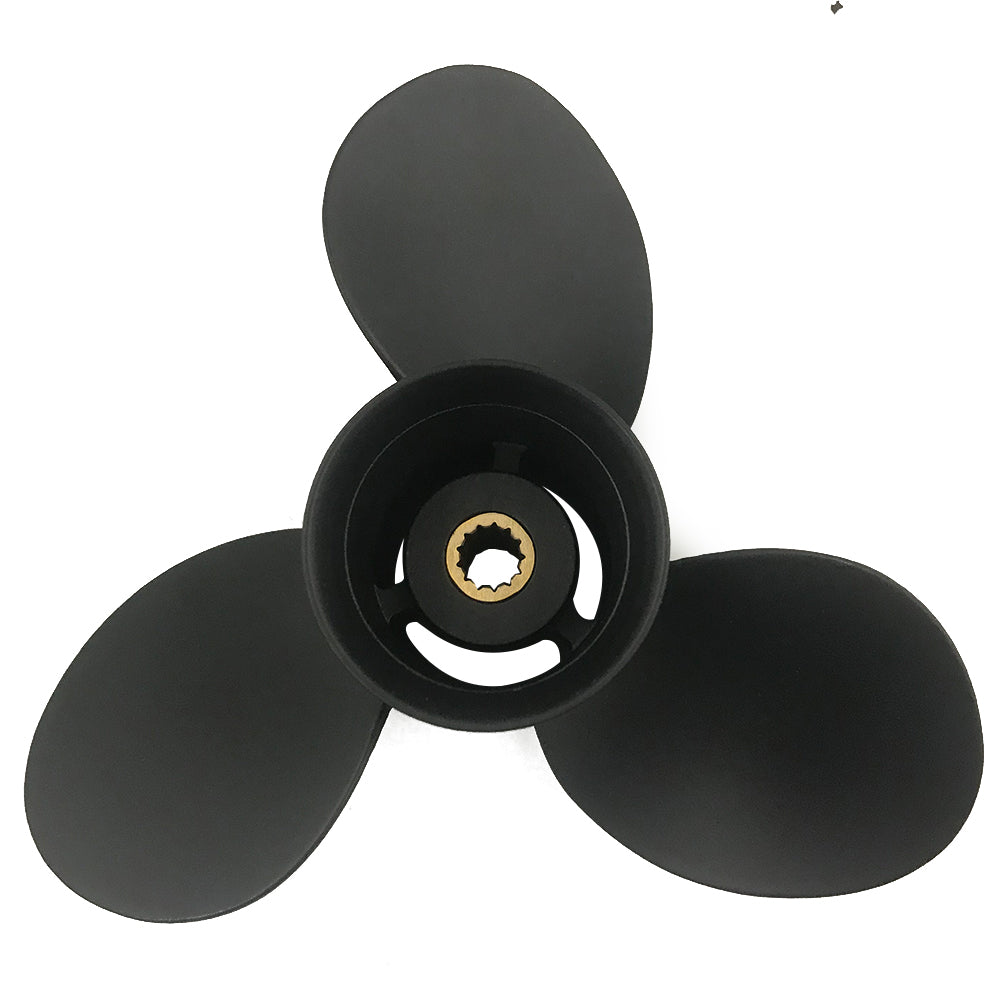Boating enthusiasts are aware of the numerous maintenance tasks required to keep their vessels in good condition. One crucial yet often overlooked issue that can ruin an otherwise smooth day on the water is a spun prop. Hence, one should understand the symptoms of a spun prop to avoid those sudden interruptions and work the boat efficiently. This article will further explore the various symptoms of a spun prop, teach you about the effects on boat performance, and present solutions to tackle the problem. Whether you are an experienced boat carver or a novice, this common issue can save you time, money, and frustration. Read on to understand how to spot and fix a spun prop before it hinders your next water excursion.
What is a Spun Prop and its Symptoms?

Defining Spun Prop
A spun propeller hub is the classic term used to describe a situation where the rubber hub inside the propeller becomes damaged or separates from the outer casing of the propeller. This type of failure is internal, and the resultant spinning of the propeller on the shaft causes an ineffective transfer of power from the engine shaft to the water system. Thus, the propeller keeps spinning uselessly while the motor tries to reel in maximum revolutions per minute to move the boat forward. Boat owners commonly hear of such incidents, and in most cases, these are caused by wear and tear over time, sudden impacts with underwater objects, or overloading of the propeller.
Recognizing the signs of a spun prop is crucial in quickly addressing the issue. One commonly visible symptom is a sudden loss of acceleration or speed, even when the engine is running at higher RPMs. The spun hub may also cause vibration or noise coming from the general prop area. Planning becomes more difficult for the boat, or the throttle response is inconsistent. Such behavior typically mimics other issues with the propulsion system, so hold the prop up for testing purposes as soon as you're certain of the problem.
To test for a spun prop effectively, one should remove the propeller and give the hub a good visual inspection, looking for any signs of wear or separation. Another practical way of testing is to mark the alignment of the prop and the hub, then run the engine for a short time under load, and afterward check if the marks are still aligned. The quicker the action is taken when the spun prop issue surfaces, the less disruption there will be to your boating, and the greater the enjoyment gained by maintaining the system's integrity intact.
Some Common Symptoms of a Spun Hub
Early recognition and suspicion of a spun hub can save the further propagation of a problem in your propeller system, which is very expensive to repair. Most symptoms suggest that power is being lost, although the engine should be revving within its normal RPM range; the boat feels somewhat reluctant to move. It also becomes slightly difficult to maintain speed or power under load.
There are several physical indicators that may suggest the problem. For example, there might be visible damage or wear around the rubber hub or the propeller assembly. Another sign to look out for is higher-than-usual vibrations or sounds coming from the area near the propeller when the vehicle is running. If left uncorrected, the problem will only worsen, leading to poor fuel economy and increased strain on the engine. Timely checks and immediate rectification upon noticing such symptoms will prevent more significant problems from arising and keep your propulsion system in good working order.
How to Historically Recognize a Spun Prop
Identifying a spun propeller involves characterizing its symptoms and doing a few elementary inspections for confirmation. Sudden loss of speed or power while the engine continues to run at higher RPM is a common one. This happens because the hub inside the propeller has lost its grip; consequently, it spins separately from the prop blades. Another classic symptom is struggles with getting up on the plane or maintaining a steady thrust in the normal mode of operation.
To test for a spun prop, simply remove the propeller and then examine the thrust hub. Look for signs of rubber wear, burning, or displacement. Also, use a marker to make a visible mark on both the hub and the propeller blade. Reinstall the propeller and then run the engine under load for a brief period. When the marks no longer line up after this, it confirms the propeller is spinning on the hub.
In the event of an incident involving a spun propeller, immediate action is required to save fuel, promote engine efficiency, and prevent further damage to the drivetrain. Regular maintenance and the use of only high-quality propellers, preferably those with very sturdy hubs, will go a long way in minimizing the risk.
Causes of a Spun Prop

Understanding Propeller-Hub Failure
Something we can think about in respect to propeller-hub failure is that, if it measures at all on performance, its very nature says the propeller has ceased to act as pure lift. Accordingly, one of the most frequent reasons it has occurred is wear and tear. The repetitive high-stress environment, including torque transfer from the engine to the propeller, gradually weakens the hub material, ultimately leading to failure.
Another factor contributing to hub failure is the impact or strike. Impact with a submerged object, such as rocks, logs, or debris, can cause distortion or damage to the hub, ultimately leading to slip or failure. Improper installation of a propeller can also cause misalignment, leading to an uneven stress pattern and finally to failure.
Heat build-up can cause the degradation of propeller hubs. Extended periods of high-speed operation generate heat, especially in rubber-based hub systems, thereby compromising the bonding properties. This is more pronounced with the absence of adequate cooling, which, along with wear, acts destructively.
Finally, substandard materials or manufacturing faults in hub construction cause premature failure. To minimize the likelihood of breakage over time, it is essential to purchase high-quality, durable hubs with robust engineering.
Understanding the underlying causes of propeller hub failure enables one to take preventive measures, such as periodic checkups, correct installations, and investment in high-quality components, thereby promoting the longevity and efficiency of the entire propulsion system.
Factors Leading to a Spun Prop
A spun prop occurs when the rubber hub inside the prop loses grip with the propeller, resulting in the engine's rotation not being transferred to the propeller's spin. It almost always results in a severe loss of propulsion efficiency, primarily caused by wear and tear, misuse, and environmental factors.
Excessive Torque or Impact: Sudden, high torque, such as that produced by sudden acceleration, or impacts from underwater debris or a grounding, could misalign the rubber hub. Such forces, over time, erode the bond between the hub and the propeller, thus increasing the chances of spinning.
Aging or Deterioration of Materials: Like any rubber-based component, the prop hub is susceptible to wear and aging. Exposure to heat, water, and UV rays for prolonged periods can deteriorate the rubber, making it more likely to slip.
Improper Installation or Maintenance: An unaligned force on the hub can occur due to improper installation of the propeller and failure to tighten it adequately. Likewise, neglecting to carry out periodic checks can lead to inattentive deterioration if an employee is absent.
Engine Load: Running at high engine power for an extended period and at the incorrect prop pitch would impose undue stress on the hub, thereby making it prone to spinning due to excessive effort.
Corrosion and Environment: Constant exposure to saltwater or corrosive elements will degrade both the metallic and rubber components of the prop hub. The passage of time will see this degradation compromise the hub's integrity and thus set it up for failure.
Prevention attempts, such as inspections for wear, using the correct type and size of prop, and avoiding harsh operational conditions, would, more than anything else, slash the possibility of a spun prop.
Role of RPM in Spun Prop Problems
The engine speed, measured in revolutions per minute (RPM), is one such factor that affects the likelihood of a spun prop issue. When RPM is increased rapidly and excessively, a significant amount of torque and stress is placed on the propeller hub, which may cause its rubber insert to slip inside the housing. This slippage results in decreased propulsion efficiency, which is typically felt as an abrupt loss of forward thrust or inconsistent performance above a certain speed.
Continued running at high RPMs, especially under heavy load or turbulent waters, heats and wears out the materials of which the hub is made, and, with time, the heat will affect the bonding material inside the prop and degrade its ability to bear stress. On the other hand, operating at relatively moderate and steady RPMs can help avoid these problems and prolong the life of the prop and its internal hub mechanisms.
Several studies on propeller performance have indicated that high-RPM operation shortens propeller life and increases the chances of hub failure by 20 to 30% if the props are not adequately maintained. Following the RPM ranges given by the manufacturer and refraining from sudden engine acceleration can help boat operators significantly reduce instances of spun props.
Impact of a Spun Prop on Boat Performance

Speed and Throttle Response with a Spun Hub
The spun hub alters speed and throttle response on a boat, which directly defines its performance. A spun hub refers to a loose or entirely slipped connection between the propeller and the engine's output shaft. Essentially, the engine power is hardly transmitted to the propeller blades, almost nullifying propulsion. A sudden drop in the boat's speed is directly experienced as the engine RPMs remain constant or even increase.
The throttle response is very noticeable. The operator might find a situation where, after advancing the throttle, there are high engine revs and the speed does not increase proportionately—a typical sign of power loss. This power loss situation is commonly referred to as prop slippage and can prevent the boat from getting on plane, resulting in inefficient fuel consumption and poor performance. Therefore, to avoid disturbances resulting from propeller hub misalignments and maintain good performance during operations, proper maintenance is mandatory.
Implication of Not Attending to Spun Prop Symptoms
Neglecting to address symptoms of a spun propeller might trigger a chain of problems affecting both performance and long-term integrity. For starters, with a constant loss of power, the boat cannot attain higher speeds, leaving operators stranded in emergencies or unable to fulfill time-sensitive assignments. Fuel consumption increases significantly due to the inefficient transfer of energy between the engine and the propeller, resulting in higher operating costs over time. Overworking the engine may cause it to overheat and wear on its internal components, and all these will do little to extend the lifespan of the central systems. Ultimately, neglecting prolonged symptoms will lead to some costly repairs or even the complete replacement of the propeller.
Beyond mechanical consequences, some safety issues have gone unconsidered. For instance, a lack of performance and reduced reliability may adversely impact the vessel's maneuverability in situations where the weather is unpredictable or one navigates high-traffic waterways. Through regular inspection of critical parts and the immediate resolution of any issues arising from a spun hub, operators can maintain performance, reduce risk, and achieve maximum efficiency across all their operations.
Effect on Outboard Motor Efficiency
The fixing of a spun hub could drastically affect, deteriorating the efficiency of outboard motors. The most obvious and immediate effect is that a reduction in power transfer from the engine to the propeller results in a slower vessel and reduced responsiveness. This inefficiency causes the engine to compensate, resulting in increased fuel consumption and higher operational costs.
Additionally, a spinning hub left unchecked for an extended period can lead to uneven wear on other components, ultimately causing long-term mechanical deterioration. Properly functioning hubs will make propulsion slightly more efficient by ensuring equal energy transfer, thereby improving the overall performance of the vessel and reducing fuel consumption by up to 15%. Regular maintenance and early intervention are of paramount importance for the survival of these systems and to realize the peak efficiency of the outboard motor.
Fixing a Spun Prop

Steps to Troubleshoot a Spun Prop
Recognize the Symptoms: Typically, the first step in troubleshooting a spun propeller is to identify the issues it causes. Common symptoms include loss of speed, poor acceleration, or an increase in engine RPMs with no corresponding increase in speed. These symptoms indicate that the rubber hub within the prop may no longer be adequately gripping the internal hub, causing slippage.
Use Observation: Unfasten the prop advertisement from the drive shaft to check and observe. The hub should be checked for any visible wear or damage, such as cracks, tears, or any melting of the rubber material. Also, look out for any debris or corrosion that may interfere with the connection between the propeller and the drive shaft.
Mark Test: To be sure of the fact that the propeller does spin, one may put a mark across the line on the outer part of the prop (the blades) and the inner hub (near the shaft's base). The motor should be run at speed for a little while, after which it is stopped and the marks are inspected. If the lines are no longer aligned, it indicates that the hub is slipping.
What are some Repair Options: If the hub is spinning, it is best to see if it can be repaired or if it will need to be replaced. Many of the current generation props have rubber hubs that can be pressed out and replaced, saving money and time. However, most of the older models will require replacement of the entire propeller.
Check the Propeller Shaft: While the propeller is being addressed, inspect the propeller shaft. Any bends, alignment issues, or damage will only compound the problems the propeller already has in terms of efficacy. After repairs have been done, optimal performance can be ensured if the shaft is kept clean and in proper condition.
Replace or Repair the Hub: If the hub requires replacement, use the propeller press tool to remove the old hub and install the new one. Be sure to install it according to the manufacturer's specifications to avoid improper installation that may become problematic.
Perform Water Testing: After the hub repair or replacement is completed, water testing must be conducted to verify proper propeller function. Test smooth operation, acceleration, and steady speed to confirm whether the problem has been rectified.
Implement Preventive Maintenance: Regularly inspect your propeller and hub to prevent undue damage. Remove any debris and inspect for signs of wear and tear. Ensure that the propellers are securely fastened to the shaft. This way, you can keep your components from prematurely wearing out with routine maintenance and ensure better performance.
How to Replace a Spun Prop or Hub
Resisting technically may be easy, thus preventing any further damage while allowing the equipment to regain its best performance. The following steps should be able to ensure the replacement is done efficiently:
Identify Symptoms of a Spun Hub: Check the symptoms that would verify the existence of a spun hub, such as loss of power, slipping at high RPMs, and excessive vibration. Inspect the propeller for visible damage or wear, and ensure that the hub is securely attached to the prop body.
Gather Tools and Materials: You should have tools such as a wrench, rubber mallet, screwdriver, thrust washer, and marine-grade grease. Have a replacement hub kit or propeller that is compatible with your engine specifications.
Remove the Damaged Propeller: Disconnect the engine and turn it to neutral for safety reasons. Remove the prop nut using the wrench and carefully slide the damaged prop off. The hub may need to be gently tapped using the rubber mallet if it has deteriorated or fused.
Inspect the Driveshaft and Propeller Shaft: Clean, then inspect the driveshaft and surroundings for dirt, corrosion, or damage. Check that the spline is intact and ready to accept a new prop or hub. If there is any damage, inspect and repair it before proceeding, as this will prevent future problems.
Installing a New Hub or Propeller: Lightly grease the driveshaft with marine grease to ensure smooth operation and to prevent any possibility of seizure. Place the thrust washer first on the driveshaft, followed by either the new hub or the propeller, whichever comes first. Align the splines perfectly, as they must fit snugly and slide into position.
Secure the Propeller: Reinstall and tighten the propeller nut firmly with your wrench. Ensure the locking device, such as a cotter pin or tab washer, is installed to prevent the propeller nut from loosening during operation.
Test the Installation: Have your engine run at low jet as an afterthought to smooth testing of the propeller and to see if it engages properly. Take a close look at stability and be aware of any unusual vibrations.
Measure Results After Replacement: Observe how the craft performs in the field, in terms of acceleration, speed, and efficiency, and keep an eye on the propeller after a while to make sure that it is secured and doing its job.
When a spun prop or hub is adequately replaced, the boat's performance is restored, and other components are not damaged. Regular maintenance, which allows for early detection of wear, will go a long way in preserving your equipment and enhancing its reliability.
Choosing One's Spare Prop and Hub Kit
When choosing a spare prop and hub kit, it is essential to ensure that it operates smoothly and reliably while out on the water. The specifications of your vessel come first, encompassing engine size and horsepower, as well as extensive use cases, such as cruising, fishing, and watersports. Ideally, the spare prop corresponds to the size and pitch of the existing one, as these are defining characteristics that affect performance, fuel efficiency, and handling.
In a material evaluation, aluminum props are lightweight and inexpensive; hence, they are generally used for recreational applications. Stainless steel, in contrast, possesses good durability and is, therefore, used where heavier use is expected or resistance to impact is required. Then comes the crucial selection of the hub—the majority of contemporary props have modular hubs that can be a matter of convenience if they need replacement, because, metaphorically speaking, such a small investment can save you a few days. Thus, kits with interchangeable hubs can provide you with greater freedom to adapt to different props or scenarios.
Additionally, select kits that include all wear indicators, corrosion-resistant parts, and a straightforward installation process. This ensures that replacements are quick and that durability is guaranteed. By selecting a top-prop and hub kit for spare parts that meet your boating requirements, you maximize performance while being prepared for any unexpected challenges on the water. Maintenance should be a top priority in your boating projects to keep your boating ventures enjoyable and free from backaches.
Preventive Measures for Spun Prop Issues

Regular Maintenance Tips
From my experience, keeping propellers maintained fairly constantly is the best way to prevent problems such as a spun propeller and ensure that the prop performs well. Cleaning always comes first after every boating trip—the entire operation consists of clearing debris and marine growth, as well as fishing lines wrapped around the prop. It sounds simple, but this goes a long way in avoiding damage and ensuring the prop works as intended.
I carefully inspect the prop for wear or damage. Dents or deformations will cause serious performance problems, so if I am already convinced that something is wrong, I take it immediately. Another essential way to make a check about tightening the prop nut is really to make sure that the propeller has to be tightened, so a visual inspection then follows of the prop hub and another component to make sure they are all in good condition.
Lubrication and anti-corrosion treatment are never far from my consideration. Lubrication helps reduce friction and therefore enhances efficiency, while the anti-corrosion spray protects the prop from rusting and corrosion in the saltwater environment. I would say that sticking to this formula helps ensure my propellers stay in good shape and that I have an enjoyable boating trip free from worries.
Tracking RPM and Performance Indicators
Regarding RPM and performance indicators, I regularly track engine RPM during operation. This ensures that the engine is neither overused nor underutilized, both of which can lead to inefficiencies or potential issues. Watching RPM stands in consequence to its range recommended by the manufacturer, so that it can be a matter of seconds to determine if there is a need to adjust the throttle or to argue that the load on the engine must be changed. This approach has enabled me to maintain optimal operational conditions and minimize unnecessary wear.
These days, the DK¹ demands an observer´s attention to other functioning parameters such as fuel consumption, speed, and engine temperature. For instance, if I notice that fuel consumption rises suddenly or the speed drops at a constant RPM, this could indicate trouble with either the propeller or the engine. Also, tracking engine temperature helps in an early stage recognition of overheating conditions and thus prevents extensive damage. Such preliminary checks help me gather important information, allowing me to work on them promptly so that I can eventually have a flawless and pleasant boating experience.
In my experience, a proper combination of these observations with established maintenance constitutes an all-around approach to maintaining performance. Thus, by keeping my eyes open for these indicators, I will be able to make informed decisions concerning the engine, thereby ensuring its longevity, as well as that of the vessel. It is about being mindful of minor changes that can serve as warnings for bigger issues, allowing us to mitigate their effects sooner rather than later.
Recommendations on Treating Outboard Motors
Caring for my outboard motor involves adhering to certain key principles to ensure the engine runs smoothly and efficiently. One such simple thing is that I always stop and flush the motor with fresh water after being out, especially if there is saltwater involved, to avoid corrosion from salt and the accumulation of debris inside the cooling passage, which would significantly contribute to wear and tear over time. Occasionally, at least once a day, including a final check before returning the boat to the water, I inspect the propeller, removing it to ensure that no fishing lines or debris might damage the seals or impair performance.
Routine maintenance is another crucial issue that I consistently prioritize. I ensure that I schedule oil changes at the correct times with high-quality oil that is specifically designed for my engine and use the proper filters. Then, I examine the fuel system for any leaks and replace the old fuel filter to keep contamination from affecting the motor’s operation. I keep track of the spark plugs too, since clean and effective plugs will give optimum performance to the engine.
Storage of the outboard motor in the off-season is the last one. Fuel is stabilized; the battery is disconnected, and the motor is stored upright in a dry, well-ventilated area. All these efforts keep the motor safe and, at the same time, save a significant amount of time and money by addressing potential problems before they even arise. Adhering to these best standards keeps the engine dependable and ensures that my boating outings flow smoothly and are fun without a worry.
Reference Sources
-
Guide to Spun Props - Michigan Wheel Blog
Explains what a spun prop is and how it affects the connection between the engine and propeller. -
How to Diagnose and Deal with a Spun Hub? - Mercury Marine
Discusses causes of spun hubs, including aging rubber hubs, and how to address the issue. -
What Causes a Spun Prop Hub? - Boating Magazine
Highlights symptoms like power loss and prop slipping at high RPM, along with potential causes. -
How to Diagnose and Fix a Spun Prop - Captain Propeller
Covers common symptoms such as loss of speed, inconsistent propulsion, and poor acceleration.
Frequently Asked Questions (FAQs)
What are the symptoms of a spun prop?
When a propeller spins within its hub, it exhibits several symptoms, including a distinct loss of power or poor acceleration. There could be this strange situation where the RPMs just keep rising notwithstanding no augmentation to speed, in technical terms, we're referring to the prop slipping. This is often accompanied by horrible noises, followed by grinding or whining, indicating an issue within the prop shaft or hub assembly. Other manifestations include severe vibrations created by the spun prop, which affect your outboard motor's performance. If any of these symptoms are observed, an inspection of the propeller and hub should be carried out at once to preclude any further damage.
How can I repair it?
If your prop has spun, either reconditioning or replacing will be necessary. You must first remove the prop to clear the hubs and splines for visual inspection of all apparent damage, such as a ding or a worn-out bushing inside the hub. If the hub has spun and is wearing, then substitute it with a new hub to ensure a tight fit. There are cases in which a marine mechanic can press in a new bushing inside an old hub if the hub assembly is still straight in the first place. Always mark a line on the hub never to forget the original orientation and to check the effectiveness of your fix later.
What causes a spun prop?
How could a spin be induced on a propeller? Spropping can result from anything, including poor installation and excessive wear on the propeller hub. Rather than a metal-to-metal spindle, it is mounted to the shaft via a soft bushing, which over the years can wear down and allow the prop to slip on the shaft. Then, conditions arise at high rpm, wherein damage to the shaft or improper securing of the propeller itself can cause the hub to spin. Regular maintenance and proper care of the prop shaft, along with the lower unit, can help prevent such problems. Other times, environmental factors carry a heavy force of a submerged object, thus adding impetus to the hub. So be wary during navigation.
How can I tell if my propeller hub has spun?
Observe your outboard motor's performance to check if the propeller hub is spinning. Noticeable loss of power during acceleration can result from a slipping hub. Also, check for abnormal noises when the engine is at high revs, as this may indicate that the hub is slipping and not engaging thoroughly with the gearcase. Another check would be to mark the hub and the prop blade and see if there is any difference in rotation between the two during engine operation. When all other suspects, including your gearcase or drivetrain, have been checked and the symptoms persist, consider a further inspection.
What should I do when the outboard is losing power?
If the outboard motor loses power, the first step is always to check for any signs of a spun prop or slipping hub. Verify if the prop blade is not damaged or locked. Secondly, ensure the throttle is operating correctly and that there is no blockage in the fuel system. If everything checks out fine, then the lower unit and propshaft should be inspected for possible failure or wear. If none are found and you will not be able to solve it, a prop shop or a marine mechanic's assessment may help shed light on it.
Can I use a spare prop and hub kit for my outboard?
If you go for this option, you will end up with your spare prop and hub kit. Because they may be experiencing issues related to slippage or spinning on the existing one, ensure the spare prop matches the specifications of your outboard motor, including size and pitch. A new prop will usually enhance performance and eliminate power loss problems. Before setting the prop, check the hub for wear and verify that it is correctly aligned. Keeping a spare prop by your side at all times could save you and means you're always ready for a ride on the water.
